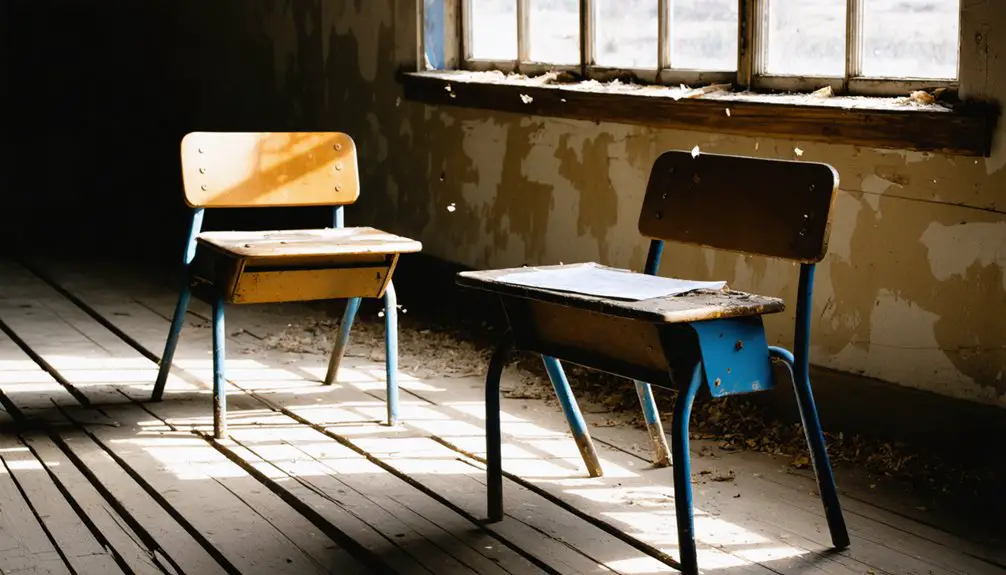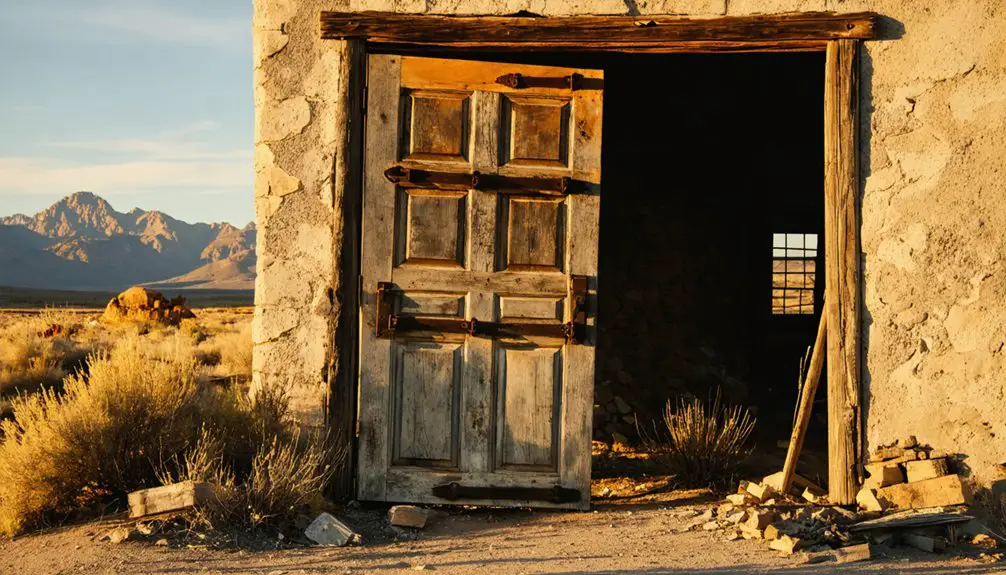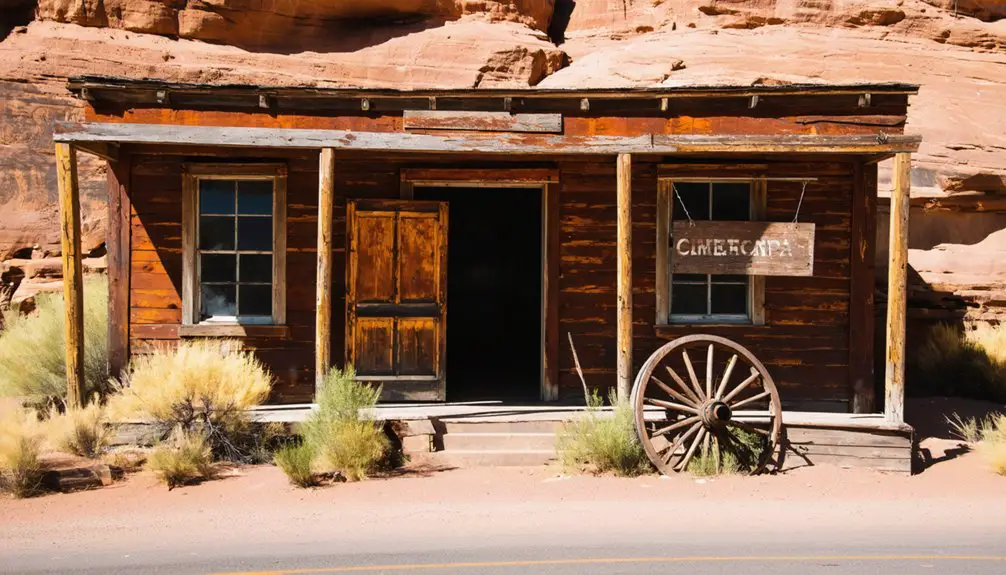You’ll find Mutual, Utah in Spring Canyon, where it operated as a pioneering coal mining cooperative from 1919 to 1938. The town centered around its two-story company store, which hosted movies, dances, and boxing matches for miners and their families. While the mines closed in 1938, the store remained open until 1954, outlasting the town itself. The remnants of this unique cooperative venture tell a fascinating story of shared ownership and community spirit.
Key Takeaways
- Mutual was a coal mining town established in 1919 near Helper, Utah, operating as a cooperative venture under the Mutual Coal Company.
- The community was anchored by the two-story Mutual Store, which served as a social hub for movies, dances, and other activities.
- Mining operations included three major mines accessing 8-foot-thick coal seams, producing over 63,000 tons by 1921.
- The town’s infrastructure featured a 600-foot tramway, railroad connections, and essential facilities like schools and a doctor’s office.
- Mutual declined as mining profitability decreased, with the Mutual Store closing in 1954, sixteen years after mining operations ceased.
The Birth of a Cooperative Mining Town
While most Utah mining towns emerged under private or corporate control, Mutual broke new ground in late 1919 as a cooperative venture at the western edge of Spring Canyon near Helper.
Under the leadership of Fred J. Leonard, the Mutual Coal Company established a revolutionary model where you could become a shareholder and receive discounted coal prices, embodying true cooperative principles.
Within its first year, the mine achieved remarkable success, producing 63,076 tons of coal by November 1921.
The mine boasted three coal seams, with one seam measuring an impressive eight feet in thickness.
A Unique Business Model in Spring Canyon
Unlike other mining operations in Spring Canyon, the Mutual Coal Company pioneered a revolutionary cooperative business model in 1919 that transformed traditional mine ownership.
Under the leadership of Fred J. Leonard, this innovative approach fostered unique cooperative dynamics through shared ownership and community engagement. The thirty million tons of coal produced in the district by 1946 demonstrated the success of cooperative mining ventures. The mine’s location in Spring Canyon, Utah was part of a 10-kilometer stretch that included six different mining camps.
Shareholders received discounted coal prices, making ownership financially rewarding.
The independently-owned Mutual Store served as a vibrant social hub with a theater, dance hall, and boxing arena.
Multiple mines operated under cooperative ownership, producing 1.5 million tons of coal between 1921-1931.
Integration with neighboring communities enhanced regional connectivity, allowing residents to access schools and postal services in nearby Rains.
Life and Community Along the Coal Seams
If you’d lived in Mutual during the 1920s, you’d have experienced a tight-knit mining community where daily life centered around the two-story Mutual Store, which served as more than just a mercantile.
Your family would have joined other miners’ families at the store’s multi-purpose amusement hall for movies, dances, boxing matches, or union meetings, creating strong social bonds in this coal town. Workers could transport up to 4,000 tons of coal through the modern steel tipple in just eight hours.
Like many Utah coal towns, Mutual’s immigrant labor force contributed to the diverse cultural fabric of the community, bringing traditions and customs from their homelands. The community’s spirit was further strengthened by shared experiences at local gathering spots like the Rains school and post office, where miners and their families supported each other through the challenges of coal camp life.
Daily Mining Town Life
As residents of Mutual settled into their mining camp in 1921, daily life centered around the impressive two-story Mutual Store, which served as the heart of the community.
You’d find miner’s camaraderie flourishing within its walls, where communal gatherings brought the town together. Like many Utah mining communities of the era, the workforce included foreign immigrants recruited by labor agents to fill the constant need for miners.
Inside this privately-owned establishment, you could experience:
- Entertainment at the amusement hall, featuring movies, dances, and boxing matches
- Recreation time at the pool hall and saloon, where miners unwound after long shifts
- Medical care at the resident doctor’s office, ensuring workers’ health needs were met
- Union meetings that strengthened the workforce’s collective voice
While your children attended school in nearby Rains, you’d find everything else you needed right at the Mutual Store, making it your one-stop hub for both necessities and leisure.
The town grew around the mining operation, which boasted three rich coal seams that provided steady work for the community’s breadwinners.
Workers Supporting Each Other
While many mining towns operated under strict company control, Mutual’s cooperative ownership structure set it apart in 1921. You could buy shares in the Mutual Coal Company, giving you both a stake in its success and discounted coal prices – a rare opportunity for miners to invest in their workplace.
The two-story Mutual Store became the heart of community networks, where you’d find Italian and Greek workers alongside their American counterparts. Its union hall fostered labor unity, while the boxing arena, movie theater, and dance floor brought everyone together after long days underground.
The doctor’s office provided essential care, and the shared facilities with nearby Rains, including their schoolhouse and post office, strengthened regional bonds. This spirit of cooperation helped workers support each other through the challenges of mining life.
Mining Operations and Technical Infrastructure
If you’d visited Mutual’s mines in 1921, you’d have seen three main tunnels accessing coal seams up to 8 feet thick, with Morton #1, Morton #2, and Mutual #3 all in full operation.
Similar to Spring Canyon above Helper, the mines operated under Jesse Knight’s ownership during the early years. The mine’s 600-foot surface tramway transported coal from the upper seam down to a newly constructed tipple, where the coal was processed and loaded for distribution.
The technical infrastructure expanded through the early 1920s as the operation grew to include three additional mines on both sides of Spring Canyon, though all mining operations would eventually cease with Western Mine being the last to close. Much like the Silver Reef mines that closed in 1891, Mutual faced the inevitable decline that many Utah mining towns experienced.
Mine Layout and Design
The development of Mutual’s mining complex in the early 1920s showcased a sophisticated layout spanning three major operations: Morton #1, Morton #2, and Mutual #3.
You’ll find the mines strategically designed to access multiple coal seams, with advanced mine ventilation systems connecting the underground networks.
- The uppermost seam connected to a 600-foot surface tramway, leading directly to the central tipple
- An 8-foot thick middle seam provided the richest source of coal extraction
- The lowest 6.5-foot seam sat closest to the tipple, optimizing transport efficiency
- Underground galleries linked to neighboring Carbon Fuel Company’s operations, creating an extensive network
This integrated design helped Mutual produce over 1.5 million tons of coal in just a decade, while maintaining critical seam extraction across multiple levels.
Equipment and Transport Systems
As operations expanded throughout the 1920s, Mutual’s mining complex developed a sophisticated transport network centered around its wooden train trestle and railroad infrastructure.
You’ll find that mining logistics relied heavily on both animal power and rail systems, with mule-drawn wagons hauling one-ton loads of coal to transfer points before reaching the main railroad line.
The transport equipment included essential underground mechanisms for moving extracted coal, while cement structures without windows housed crucial machinery and storage facilities.
You can still trace the original railroad route today, now embedded beneath a modern paved road.
These transport systems weren’t just crucial for coal shipment – they connected Mutual’s miners to neighboring camps like Rains and supported the community’s lifeline to wider distribution networks.
Coal Processing Operations
While Mutual’s transport systems moved coal across the region, its mining operations centered on the rich “Sub 2” coal bed beneath the Castle Gate floor.
The Mutual Coal Company‘s coal extraction techniques focused on room and pillar mining, following the seam’s 5-degree northeastern dip while maintaining safety and efficiency.
- Processing operations ramped up quickly, hitting 63,076 tons in late 1921
- Production capacity doubled to 132,000 tons by 1925
- Onsite processing innovations included tipples with 150-200 ton daily capacity
- Robust stone buildings housed essential processing equipment and facilities
You’ll find evidence of their technical expertise in the careful balance of extraction methods with structural support systems, which helped maintain the mine’s impressive output until operations ceased in 1938.
The Company Store Legacy
Standing as a proof of community independence, Mutual’s privately owned store defied the typical company-controlled economy of 1920s mining towns. Built in 1921 by Joe Pauagano and later owned by the Johnsons, this two-story stone marvel showcased how store independence could reshape community dynamics.
You’d find more than just supplies within its walls. The ground floor housed a pool hall, saloon, and doctor’s office, while upstairs, an amusement hall hosted everything from union meetings to boxing matches.
The store’s unique position as a community nucleus served both Mutual and Rains residents, outlasting the mines by 16 years until its closure in 1954. While other company towns restricted their workers’ economic freedom, Mutual’s store represented a rare example of commercial autonomy in Utah’s mining history.
Daily Life Without a Local School

The lack of a local school set Mutual apart from typical mining towns of the 1920s. Instead of walking to a neighborhood schoolhouse, children faced daily school commuting to nearby Rains, about half a mile away.
While this arrangement wasn’t ideal, families adapted to maintain their children’s education.
The impact on daily life was significant in several ways:
- Students had to brave weather conditions year-round to reach their classes.
- Community engagement shifted to the Mutual Store’s second floor, where families gathered for entertainment.
- Children’s social circles expanded beyond town boundaries, mixing with peers from other mining camps.
- Parents coordinated transportation and schedules around the Rains school system.
The unique educational setup reflected Mutual’s cooperative spirit, even as it challenged traditional mining town conventions.
The Path to Abandonment
Despite its promising start as a mining settlement, Mutual’s path to abandonment followed a pattern common to many Utah ghost towns in the early 20th century.
You’ll find the abandonment reasons centered on the classic boom-and-bust cycle that plagued mining towns throughout the region. When mineral deposits proved less profitable than expected, miners and their families couldn’t sustain their livelihoods.
The push for community consolidation, similar to what you’d see in other declining settlements, also played an essential role. Like Grafton’s residents moving to Rockville, Mutual’s inhabitants gradually sought better opportunities in larger, more stable towns.
The town’s remote location and harsh environmental conditions only hastened this exodus, as you couldn’t rely on diversified economic activities to keep the community afloat.
Remnants and Historical Significance

Nestled at Spring Canyon’s western end, Mutual’s most prominent remnant – the two-story Mutual Store – stands among scattered ranching equipment and corrals, offering a glimpse into the town’s cooperative mining heritage from 1919.
The historic Mutual Store rises above Spring Canyon’s landscape, a weathered sentinel guarding memories of Utah’s cooperative mining past.
For ghost town exploration enthusiasts and historical preservation advocates, you’ll discover a unique story of communal enterprise amid the ruins.
Key remnants tell the tale of this distinctive mining settlement:
- Mining infrastructure including tramway scars and tipple foundations
- Scattered miner houses that once housed the workforce
- The iconic store building that served as a community hub until 1954
- Surface features showcasing three productive coal seams, including an impressive 8-foot thick deposit
These physical remains stand as proof of Mutual’s significance as Utah’s rare cooperative mining venture, which produced over 63,000 tons of coal by late 1921.
Frequently Asked Questions
Are There Any Remaining Structures Still Standing in Mutual Today?
Like whispers of the past, you’ll find very few remaining buildings in Mutual today. Historical preservation efforts haven’t maintained structures, and reliable sources indicate only scattered ruins remain standing.
What Were the Average Wages for Miners in Mutual During Operations?
You’d have earned extremely low mining wages in early 1900s Mutual, facing a brutal 30% cut around 1920. The economic impact led miners to strike for better pay in 1917 and 1922.
Did Any Major Mining Accidents or Disasters Occur in Mutual?
You’ll find no major mining accidents or disasters documented at Mutual during its 1921-1938 operations. While historical accidents plagued Utah’s coal industry, mining safety records show no significant incidents at this site.
Like dust in the wind, you’d have witnessed massive shareholder migration as investments became worthless. During the 1940s-50s, cooperative members faced devastating economic impact, forcing relocation to nearby mining towns.
Were There Any Notable Ghost Stories or Legends Associated With Mutual?
You won’t find documented haunted tales or spectral sightings from Mutual’s history. While abandoned buildings might spark ghost stories today, there’s no evidence of supernatural legends during the town’s mining years.
References
- https://www.legendsofamerica.com/mutual-utah/
- https://jacobbarlow.com/2020/02/25/mutual-utah/
- https://www.stephenwade.com/blog/articles/sunday-drive-old-irontown-utahs-first-ghost-town
- https://lifeinutopia.com/utah-ghost-towns
- https://www.youtube.com/watch?v=enJ7WoZuGLc
- https://www.ksl.com/article/51308628/restored-utah-ghost-towns-that-should-be-on-your-summer-travel-bucket-list
- https://www.aol.com/10-utah-ghost-towns-rich-175501369.html
- https://scienceteacherexplorer.com/spring-cyn-ut-2007/
- https://utahrails.net/utahcoal/spring-canyon-mines.php
- https://jacobbarlow.com/2022/11/21/spring-canyon-coal-company/



